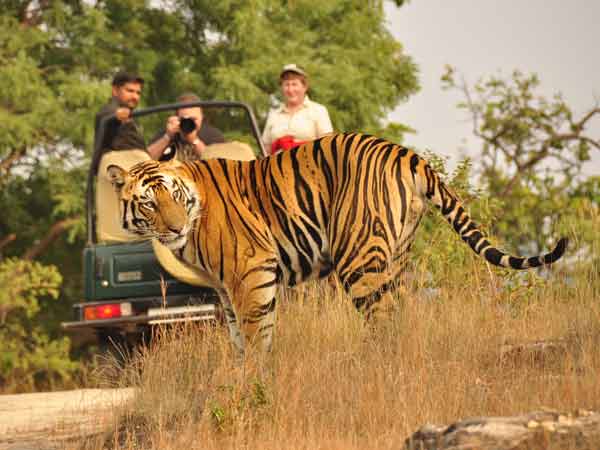
Our jeep bumps off the road, negotiates the low height of the hillock and grinds to a halt. From this vantage point, we scan our surroundings, like a hawk on a perch. We readied our cameras on tripods, to roll into action the moment we sighted our target. It has been opined that one has to be lucky to see a tiger in every other reserve, but really unlucky not to see one in Bandhavgarh. But, the tiger is the lord of his domain and not ours to command. Sitting silently in the jeep, each one of us was immersed in his own thoughts. The driver and forest guard, speaking in whispers were discussing the tiger’s last sighting; trying to predict the next one. They peered repeatedly at the ground, got our attention and pointed to the red, muddy forest floor ‘pug marks’.
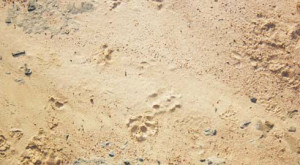
‘Pug marks! Smudgy and nearly wiped out; my companion and I felt disappointment weighing us down. Two days had elapsed, wandering the Bandhavgarh forest, morning and evening chasing leads offered by other drivers and guards. The chase led nowhere. My companion said in a bitter voice, “I think it is just publicity to get people here. There are no tigers.” My own thoughts echoed, but, I replied, “Sure there are but, we are not in the right spot at the right time. Let’s wait a bit.” Way out in the distance, water glistened throwing up showers of starry sparks in the heat haze.
The epic connection

Bandhavgarh is of an incredibly ancient lineage, stretching 2,000 years into the recesses of time and sanctified by the footprints of the God-king Ram, hero of the epic Ramayana. Ram, heir apparent of Ayodhya, was exiled to the forests by his manipulating step-mother, Kaikeyi, who wanted the throne for her own son, Bharat. Ram left the palace, accompanied by his wife Sita and brother Laxman and entered the forests to live out the stipulated 14 years of exile. Here, the demon king Ravan sees Sita and desires her. Knowing that Sita would never bend to his wish, he creates the mirage of an enchanting golden deer in the forest that catches Sita’s fancy. She insists on having it for a pet. Ram goes into the forest to catch it, leaving Laxman to protect Sita. This poses a problem for Ravan. So, impersonating Ram, he gives a distress call. On hearing Ram’s voice, Sita is upset. She urges Laxman to go and aid Ram. Laxman refuses, saying that Ram was a match for an army. Sita loses her cool and accuses Laxman of unworthy intentions towards her. In a quandary, Laxman finally draws a magical boundary around the house, asking Sita not to step out of this ‘Laxman-rekha’ under any circumstance and leaves. Having got both the brothers out of the way, the devious Ravan, posing as a mendicant, comes to the hut asking for alms. Sita steps into the hut and gets him food. Then, remaining within the boundary stretches out to place it in the sadhu’s bowl. Feigning anger at her stretching out thus, Ravan draws Sita beyond the boundary, grabs her by the hair and abducts her to his kingdom of Lanka, an island in the sea. A distraught Ram wanders the forest looking for clues to her whereabouts. He comes to the kingdom of ‘vanars’ (monkeys). Here, among two brothers, one had ruthlessly abducted the wife of the other, the rightful king, exiled him and proclaimed himself king. Ram helps the rightful king regain his kingdom. In turn the vanars promise to help seek out Sita. Hanuman, a leader of the vanars, becomes Ram’s unflinching devotee. It is he who scouts the land, locates Sita in Lanka and brings news to Ram of her whereabouts. Later, he, along with others build the ‘setu’ a bridge across the sea for Rama to cross over when war is declared on Lanka. The ‘setu’ is now an established fact and is seen through satellite imagery.

The same two vanars are also considered the architects of the fort at Bandhavgarh; used by Ram and Hanuman when they return from Lanka after vanquishing Ravan. Fourteen years over, when Ram is returning to Ayodhya, he gifts the fort to his brother Laxman, who gets to be known as ‘Bandhavdish’ Lord of the fort: The title carries on and is still used by the Maharaja of Rewa, owner of the fort. Here legend fades, reality emerges.
Historic connection
Bandhavgarh Fort sits on the plateau of a hill 811 meters above sea level. This hill is the highest amongst 32 hills and hillocks in the Bandhavgarh area, belonging to the Vindhyachal ranges in district Umaria of Madhya Pradesh. A formidable stronghold of the 10th century it forms the centre point of Bandhavgarh National Park, but remains isolated from it by the smooth hill-slopes dropping into deep valleys below and is fenced off by surrounding smaller hills.
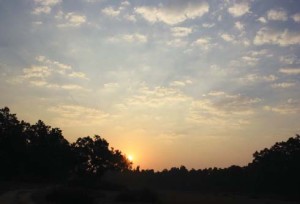
This fort is not recorded in any historical document and bears no date of construction, but it is assumed to be 2,000 years old, based on references found in texts like the Narad- Panch Ratra, Shiva Purana and its explicit association with the Ramayana.
Folklore of Madhya Pradesh indicates that the fort was constructed by the Gond kings, belonging to the Pandro caste, because its architecture is akin to other forts built by them. The Gonds also built 12 talabs or ponds a few of which still remain. The Gonds reside within the vicinity of the fort to date. The edifice is a receptacle of the history of various dynasties who ruled from its precincts. The Maurayans ruled during the 3rd century B.C. followed by the Vakatakas who remained until the 5th century; from the 6th century to the 13th century, three dynasties left their stamp on Bandhavgarh: Sengars, Kalchuris and finally the Baghels who ruled the longest from the fort; from the 13th century to the 15th century.
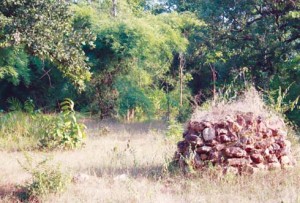
Life flowed in full measure through the fort. It became a centre for traders travelling between Kaushambi and Bharhut and was known as Bardawati. Under the Vatakas the fort became the recipient of the written word and was enriched with stone writing and sculpture. In the reign of the Kalchuris it came to be known as ‘haihay kshetra’. Karan Deo made Bandhavgarh the capital of the southern part of the Gahora kingdom in 1245. The Baghels were the last to hold the fort. They ruled from the end of the first millennium to 1494 AD. Midway, the kingdom was lost to the Kuruvanshees; but, lost in war it was recovered in love! A Baghel prince enticed the Kuruvanshee princess Kaurvi. Marriage interlocked the two clans and Bandhavgharh came back to the Baghels as a prized piece of dowry of the Kuruvanshee princess; the fort changed hands again. The Baghels settled in and ruled from Bandhavgarh, extending their territory at the same time. By 1618 AD they had extended their kingdom to such an extent that Bandhavgarh fell into a corner of it.

Administration from Bandhavgarh became difficult. Travel on horseback took weeks; distances were measured in days; the rulers needed a central location for efficient administration. They moved to Rewa. With the rulers, the administration and the army moved a large chunk of the population. Bandhavgarh lay deserted and pressures on the land diminished. Shortly, like a shout of joy, the habitat responded and the jungle reclaimed its own. Vegetative density attracted herbivores to the area and in their wake followed tigers.

Un-intentionally, the Maharaja of Rewa had laid the cornerstone for a tiger reserve. On his return to Bandhavgharh, the Maharaja was amazed and delighted to find a dense jungle teeming with tigers surrounding the fort. It was immediately proclaimed a Royal hunting reserve. Royalty had adopted the blood thirsty sport of hunting as a mark of royal breeding. Killing a tiger, marked a heroic man; that these animals were cornered and then shot did not seem to matter to those valorous men. Stories told, recount that to be known as truly heroic, the magical figure of 107 had to be attained in the hunt. To gain the title and the magical figure, Raja Gulab Singh Baghel decimated 83 tigers in just one year!
Enroute to Bandhavgarh Hill fort
A visit to the fort requires prior permission, as it is still owned by the erstwhile Maharajas. The approach road is steep and narrow and the entrance barred by an ancient gate known as the Karn Pol.

North of the Bandhavgarh mountain foothills, beginning at the edge of the Chakradhara meadow and leading all the way up to Sheshshaiya, the landscape is dotted with man-made caves, dug out of sandstone, conclusive evidence of human activity of a bygone era. They bear ‘brahmi’ inscriptions and have rock paintings credited at being the oldest. Several caves have etched animal figures of the tiger, pig, elephant and horsemen on their walls. The largest of these, called ‘badi gufa’ (big cave), has a broad entrance, nine small rooms and several pillars. It is spacious with an adequately high ceiling for a person to stand upright, but, in every other aspect, appears, primitive. The caves are of indeterminate purpose, but suggestive names help in conjecture. Thus, there is the Astabal – stables, Kachheri – courtroom, guardrooms, and others. There 39 caves, all of which lie within a circle of five kilometers around the old village of Gopalpur and are now taken over by tigers and bats.

Moving up the hill one encounters the sculptures of Vishnu’s incarnations; Varah – boar, Matsya – the fish, with dimensions of 9 feet, 2 inches by 11 feet 2 inches; Kurma or turtle is the largest of its kind in India and the 18 feet high Narsimha, carries the head of a lion on the body of a man. The most famed, is the enormous sculpture of Lord Vishnu reclining on the body of the seven-hooded serpent, Sheshnag, called Sheshshaiya. The Lord of the world sleeps with his head to the east and legs to the west. From near his feet, gushes a stream – the Charanganga that waters Bandhavgarh. On Janmasthami, Lord Krishna’s birthday, devotees flock to Sheshshaiya and the temple of Bandhavadheesh that enshrines Laxman, the brother or ‘bandhu’ of Lord Ram, and also Ram and Sita. The temple is actively used and a priest remains in residence. The Fort is held in great reverence as it has all 10 of Lord Vishnu’s avatars.

Next to the temple is a large tank, the Rani Talab. On its banks stands Rani Mahal, queen’s residence also called Moti Mahal, because of its enchanting and imposing structure that is reflected in blue-green water. Several small temples with elaborate carvings dot the periphery of the tank. Opposite the Bandhavadheesh temple stands the Bhandar or treasury.
Famous men who left their mark
Bandhavgarh seems to have exerted a magnetic pull, particularly on those, destined to leave a mark on the sands of time. In the 16th century the famed poet and saint, Sant Kabir was drawn to the area. A story goes that, Kabir gave a salutation to the whole of central India.The Maharaja of Rewa had heard about Kabir and was informed about the saint’s arrival in his kingdom. He invited the saint to his fort palace. When the saint arrived, the Rajput king was in a dilemma. As Kabir was not a Brahmin by birth, the Maharaja could not touch his feet in reverence. Kabir solved the problem by saying “Salaam Sahib” and the Maharaja reciprocated; ever since, this has become the traditional way of greeting in Bandhavgharh. Kabir is known to have stayed in Bandhavgarh Fort for some time. A Kabir temple marks the place where the saint meditated and held discourses for his coterie. His first disciple, the wealthiest merchant of Bandhavgarh, Dharamdas Naam Sahib, was initiated here.

Another twist in the tale is that, when Humayun was on the throne of India, Sher Shah Suri, the Afghan invaded it. Humayun’s queen, pregnant at the time, was sent away to Bandhavgarh, as the fort was believed to be extremely secure. Akbar, was in fact born in Kalinjar fort, north of Bandhavgarh. Akbar was never able to sever his connection with Bandhavgarh. As an emperor, he kept an eye on it all the time and was informed of all that was happening there. When Tansen, the great musician joined the court of Rewa under Raja Ramachandra Baghela, Akbar sent one of the fabled gems of his court, Birbal, to invite and escort Tansen to the Moghul court. Birbal was welcomed at Bandhavgarh and liked the place so much that he decided to stay on a while. A palace called Birbal Bhavan within the fort testifies to Birbal’s extended stay at the court of the Baghels. An infuriated Akbar, then sent his army to conquer Rewa, but, at this point, Tansen himself mollified the emperor, defused the tension and shifted to Agra.
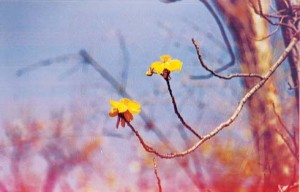
Back to the present
The sun blazed overhead. We sat in the open jeep with our guide and driver fascinated by their narration of Bandhavgarh’s story. I was in a daze, grappling with the fact that we were actually in the vicinity of the oldest fort in the world. That Ram and Laxman had actually lived and walked through these very forests in which we were moving around. I wondered how this royal trio walked unafraid through the jungle, most definitely denser then, than it was now and teeming with wild animals. That was a time when man was in sync with nature and living in the forest was very natural, for it contained all the resources to sustain life.
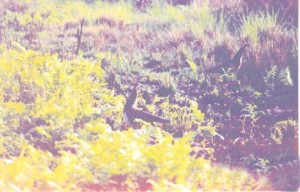
Shaking myself out of my reverie, I breathed deeply as I pondered; true; we had been exceptionally unlucky for the tiger eluded us constantly. But hope always reigns supreme. I looked around and absorbed the beauty of the varied terrain. Green hills in the distance, bare rocks in the foreground, stubby yellow stalks of grass poking up from fissures in the earth and the mud tracks on which we so anxiously and hopefully motored around. The still haze was shattered by the shrill call of langurs, followed by an anxious bark from the deer. “The tiger is on the move”, said the forest ranger. “Let us move closer to the pond. Perhaps the tiger is heading there for a drink”. We nodded our assent. The driver gunned the jeep’s engine to life and we steadily slipped off the hillock and joined the mud track below.

Bandhavgarh National Park
Bandhavgarh Hill being the centre point, the reserve bears its name. The park lies between the Vindhya mountains and the eastern flank of the Satpura hill range. It spreads out between Shahdol and Jabalpur districts in Madhya Pradesh. The hill is a sandstone formation and allows water to permeate into it. As a result, there are several springs and streams that originate from it. The rivers Son and Johilla on the east side and the river Umrar flows on the west side. The hill-top is a plateau with marsh meadows. Bamboos and Sal cover the plain tracts, degenerating in growth and quality as they ascend the hill, owning to edaphic conditions. A rare species of insectivorous plant like Drocera peltata and a medicinal plant, the Acorus calamus or Buch are found in isolated patches of the Tala range.
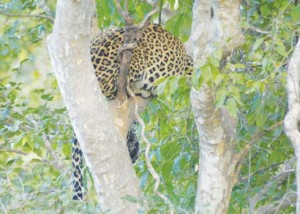
the foliage
Untill 1947, Bandhavgarh remained a royal hunting ground or Shikargarh for the Maharajas of Rewa, but post independence, princely states were abolished and Rewa became a part of Madhya Pradesh State. Wildlife and forests were the least of the new government’s worries. Lack of protection gave poachers a free hand and degradation of forests set in. The erstwhile Maharaja, Martand Singh of Rewa, was disturbed by this wanton destruction and proposed than an area of 105 square kilometers be declared as a National Park. No conservation measures were taken until 1968, when the area was constituted as Bandhavgarh National Park.
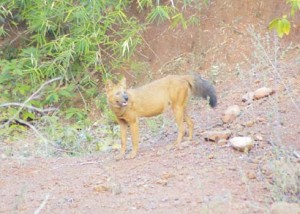
Across the country, poaching was rampant: The tiger was on the verge of extinction. Project Tiger was initiated in 1972 and the Wildlife Protection Act 1972 came into force. In Bandhavgarh, it was realised that demarcating only 105 square kilometers as tiger habitat was insufficient. So, in 1982, three more ranges, namely Khitauli, Magdhi and Kallawah were added to the Tala range – the original Bandhavgarh National Park. Bandhavgarh became part of Project Tiger in 1993 at which time the adjoining Panpatha Sanctuary was added to the reserve.
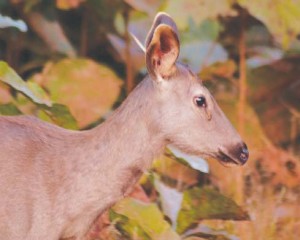
In search of the tiger
We motored around the park on roads cut out for jeeps. The entire forest area is rocky and hilly, nurturing a mixed deciduous forest in patches. Some trees, were leafless, but held up beautiful bright yellow flowers, like golden cups holding an offering of nectar to the sun. Coral tree flowers bloomed in clusters of bright red or orange. The scene was kaleidoscopic changing from deep green and grey, to brown, orange-red and yellow. We encountered chital deer grazing quietly amidst grass filled rockbound spaces. A handsome antlered stag with his harem and their young, kept a wary eye on the surrounding as he grazed. Along the track, the guide\ spotted small pug marks, those of a cub going in the direction of a drying water hole and we followed them, until suddenly there were no more. Our guide said that their information was that the tigress had moved deep into the forest with her cubs to shelter from the rising temperature of the advancing day. So, we back-tracked and branched off along another road that led to a larger watering hole and by and by came upon a sambar. He blended perfectly with his surrounding, his colouring perfectly matching the rocks he was seated amongst, so it was difficult to distinguish him at first. Only when he flapped his ears did we really notice him. Majestic deer, the sambar are solitary and seen in ones and twos only. Later, we chanced upon a serpent eagle and a kingfisher, but of the tiger there was not a trace. The day was advancing towards noon and by park rules we had to exit, leaving the birds and beasts to their peace and quiet.
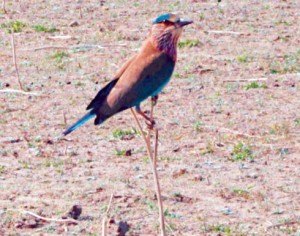
Having somehow got through our own chores without any electricity at the resort, we were back in the jungle by 4pm. The blaze of the sun had dimmed a bit and a breeze fanned our hot faces as we drove along by the road skirting the chaurs. The long dry stalks are known to be the hideout of tigers when stalking their prey. Near the waterhole we encountered a grey heron, still as a statue, standing in the pond, patiently waiting for fish to swim within spearing distance. We stopped a short distance away from the pool to watch the drama being played out at the pool. The sun was on its westward journey, and had cast a spell of quiet over the land. On the muddy shore of the pool a peacock danced in gay abandon, fanning its feathers to the fullest and twirling around like a dervish. A couple of langurs by the shore took no notice of the peacock and were intent on de-lousing each other. All was tranquil; in the words of the poet ‘God’s in His Heaven; All’s well with the world’. We moved on, our route taking us to the rear of the park with its natural fencing of tall cliffs, where only the eagles dared. White patches of bird droppings made the presence of birds very evident. The green bee-eater flitted across our line of vision complacently, a blue jay, or the Indian roller as it is also called, remained perched serenely on a rock, the grey hornbill called from the canopy of the trees nearby and the jungle fowl strutted around in the scrub.

Rich bio-diversity
The richness of Bandhavgarh’s bio-diversity is immense. There are 35 species of mammals, some of which are endangered and rare; the common langurs, Rhesus macaque, Asiatic jackal, Bengal fox, sloth bear, gray mongoose, striped hyena, jungle cat, leopard, tiger, wild boar, spotted deer, sambar, chausingha, nilgai, chinkara and gaur. The dhole or wild dogs, the small Indian civet, palm squirrel and lesser bandicoot rat are seen occasionally.
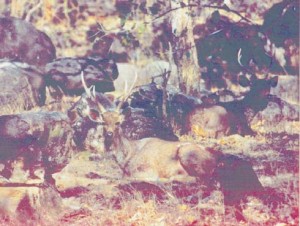
Two hundred and fifty species of birds inhabit the forests among which are the blossom-headed parakeets, making their presence known with their shrill cries, partridges, hornbills, golden orioles, falcons, golden eagles, hawks and numerous sun birds.
The Chakradhara area of Bandhavgarh, with the exception of the Western Ghats, has the highest density of butterflies. A total 111 species of butterflies inhabit this forest. Its flora is equally diverse, with 500 varieties of trees and shrubs, while the forest floor is home to 16 species of snakes. Along the edges of the forest, most parts of the valley are covered by bamboo clumps and grasslands that provide the thrills and chills of a safari.
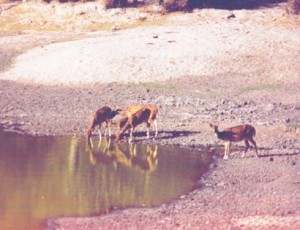
Adding to the fame of its tiger sightings was its star tiger ‘Charger’. The feats of Charger have been chronicled with religious zest. This huge dominant male once charged an elephant carrying tourists and spread panic, but earned his sobriquet ‘Charger’. Defying the normal, Charger enlivened the forests of Bandhavgarh for 17 years, while most tigers fade away in 12 to 14 years. His name is immortalised at ‘Charger Point’ the enclosure where he breathed his last.
Adieu to Bandhavgarh
At 5 am we were on the road, motoring to Chakradhara. Hope ran high that on this, our last visit to the forest we would come across the animal we so ardently sought – the tiger. We moved through the gates as soon as they were opened. The sun was just peering over the horizon at the far eastern end. In a surprisingly short while, it was a blood-red disc, seen through the tall trees and hallowed the entire area in a red glow. As we continued to move towards Chakradhara, the sun fell behind the table-top mountain. Chakaradhara, when we got there was tranquil. Nothing stirred and there were no calls from bird or beast. Surmising that the tiger was not in the area, we motored off to Gopalpur, a green algae covered lake and stopped at a safe distance from the shoreline, so as not to disturb the animals at their morning routine. A large serpenteagle, perched on a low branch, eyed us severely, as he waited to warm up in the rising sun. A couple of sambar came to the lake and began to drink water. 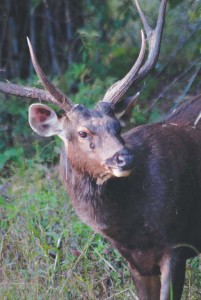
The entire drama took about five minutes to enact, but, left an indelible mark on the memory that remains etched in every detail to this very day.

